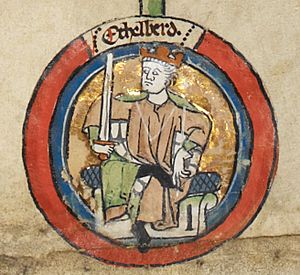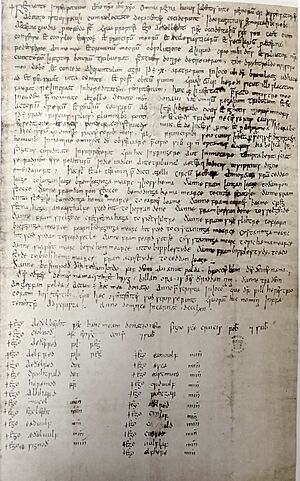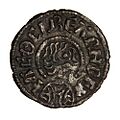Æthelberht, King of Wessex facts for kids
Quick facts for kids Æthelberht |
|
|---|---|

Æthelberht in the early fourteenth-century Genealogical Roll of the Kings of England
|
|
| King of Wessex | |
| Reign | 860–865 |
| Predecessor | Æthelbald |
| Successor | Æthelred I |
| Died | autumn 865 |
| Burial | Sherborne Abbey |
| House | Wessex |
| Father | Æthelwulf |
| Mother | Osburh |
Æthelberht (also spelled Ethelbert or Aethelberht) was the King of Wessex from 860 until he died in 865. He was the third son of King Æthelwulf and his first wife, Osburh.
Æthelberht first appeared in official records in 854. The next year, his father, King Æthelwulf, went on a special journey to Rome. During this time, Æthelwulf made his oldest living son, Æthelbald, king of Wessex. Æthelberht became king of the area called Kent, which had recently been taken over.
When Æthelbald died in 860, Æthelberht became king of both Wessex and Kent. This was the first time these two areas were fully joined under one ruler. He seemed to get along well with his younger brothers, who would later become kings themselves: Æthelred I and Alfred the Great. During Æthelberht's time as king, Viking raiders attacked the kingdom. However, these attacks were small compared to the huge invasions that happened after he died. Æthelberht passed away in the autumn of 865. He was buried next to his brother Æthelbald at Sherborne Abbey in Dorset. His brother Æthelred became the next king.
Contents
How Wessex Grew Strong
When Æthelberht's grandfather, Ecgberht, became king of Wessex in 802, it was not clear if his family would stay in power. For 200 years, different families had fought for the throne. No son had followed his father as king. Ecgberht was related to an older king, Ine, but his family line was not directly from a recent king.
However, Ecgberht's family managed to keep control of the kingdom. By the 800s, most of England was ruled by the Anglo-Saxons. The powerful kingdom of Mercia controlled southern England. But in 825, Ecgberht's Wessex army strongly defeated Mercia at the Battle of Ellendun. After this, Wessex and Mercia became allies. This was important for fighting against Viking attacks.
In the same year, Ecgberht sent his son Æthelwulf to take over the Mercian area of Kent. This area included what is now Kent, plus Essex, Surrey, and Sussex. Æthelwulf became the sub-king of Kent.
Viking raids became more common in the 830s. In 835, the Isle of Sheppey was attacked. In 836, Vikings defeated Ecgberht at Carhampton. But in 838, Ecgberht won a big victory against a group of Cornishmen and Vikings. He died in 839, and his son Æthelwulf became king. Æthelwulf then made his oldest son, Æthelstan, the sub-king of Kent.
Viking attacks continued to grow in the early 840s. In 843, Æthelwulf was defeated by 35 Danish ships at Carhampton. But in 850, Æthelstan defeated a Danish fleet near Sandwich. This was the first naval battle ever recorded in English history. In 851, Æthelwulf and his second son, Æthelbald, won a huge victory against the Vikings at the Battle of Aclea. The Anglo-Saxon Chronicle said it was the biggest defeat of a Viking army ever heard of.
Æthelberht's Family
Æthelberht was the third of five sons of King Æthelwulf and his first wife, Osburh. Osburh died around 855. Æthelstan, the oldest son, died in the early 850s. But the four younger brothers all became kings of Wessex, one after another:
- Æthelbald (855 to 860)
- Æthelberht (860 to 865)
- Æthelred I (865 to 871)
- Alfred the Great (871 to 899)
Æthelberht also had one sister, Æthelswith. She married King Burgred of Mercia in 853.
Becoming King
Æthelberht was first mentioned in official documents in 854. The next year, his father, King Æthelwulf, went on a long journey to Rome. Before leaving, Æthelwulf made his oldest living son, Æthelbald, the ruler of Wessex. He made Æthelberht the ruler of Kent and the nearby areas of Essex, Sussex, and Surrey. This showed that his sons were meant to rule these separate kingdoms, even if he returned.
In 856, Æthelwulf came back to England with a new wife, Judith. She was the daughter of Charles the Bald, the king of the West Franks. Æthelbald, with the help of some important leaders, refused to give up his kingship of Wessex. To avoid a civil war, Æthelwulf made a deal. Historians disagree on exactly how the kingdom was divided. Most believe Æthelbald kept Wessex, and Æthelberht gave Kent back to his father.

Æthelwulf planned for his kingdom to stay divided after his death. He wanted Æthelbald to be king of Wessex and Æthelberht to be king of Kent. This plan happened when Æthelwulf died in 858. The Anglo-Saxon Chronicle recorded: "And then Æthelwulf's two sons succeeded to the kingdom: Æthelbald to the kingdom of Wessex, and Æthelberht to the kingdom of the inhabitants of Kent and to the kingdom of Essex and to Surrey and to the kingdom of Sussex."
Æthelbald was later criticized by Alfred the Great's writer, Asser. This was because Æthelbald rebelled against his father and married his father's widow. However, Æthelbald and Æthelberht seemed to be on good terms. In 858, Æthelbald issued a document about land in Surrey, which was in his brother's territory. Also, Æthelberht and Judith witnessed a document Æthelbald issued in 860.
Æthelberht made some important changes in Kent. A Kentish document from 858 shows that many new officials, called thegns, were witnessing documents. This included Eastmund, whom Æthelberht later made a high-ranking official, an ealdorman, of Kent.
Æthelberht's Rule
The separation of Wessex and Kent did not last long. Æthelbald died in 860 without children. So, Æthelberht became king of both Wessex and Kent. His younger brothers, Æthelred and Alfred, were probably meant to be kings of Wessex later. But they were too young at the time. It was important to have adult kings, especially with the threat from the Vikings.
During Æthelberht's rule, Wessex and its newly conquered areas in the southeast became one united kingdom for the first time. Unlike his father and grandfather, Æthelberht did not appoint another family member as a sub-king of Kent. An official document from Kent, issued in his first year as king, included important people from both Wessex and Kent. This showed the new unity of the kingdoms.
Historian Simon Keynes said this document was very important. It showed a new kind of meeting where leaders from both Wessex and the southeast came together. This reflected the new way the kingdoms were joined.
The Anglo-Saxon Chronicle says that Æthelberht ruled "in good harmony and in great peace." He seemed to get along well with his younger brothers. In a document from 861, he gave land to St Augustine's Abbey in Canterbury. In return, the abbot promised to stay loyal to him, Æthelred, and Alfred. Some historians believe the three brothers agreed to take turns ruling the kingdom.
In 862 and 863, documents show Æthelred making grants as king of the West Saxons, and Æthelberht is not mentioned. This might mean Æthelberht let Æthelred handle some power in Wessex, perhaps when Æthelberht was away. However, a document from Æthelberht in December 863 was witnessed by Æthelred and Alfred as "king's sons." In this document, Æthelberht gave special rights to Sherborne church to honor his father Æthelwulf and brother Æthelbald.
Æthelberht's rule began and ended with attacks from the Vikings. In 860, a Viking army sailed from the Somme River to England and attacked Winchester. But the men of Hampshire and Berkshire defeated them. In the autumn of 864, another Viking army camped on Thanet. They were promised money for peace, but they broke their promise and attacked eastern Kent. These attacks were small compared to what happened after Æthelberht died. The Vikings almost conquered all of England later on.
Coins of Æthelberht
In the 700s and 800s, the only coin made in southern England was the silver penny. Wessex itself had places where coins were made, called mints. But not many coins were made there in the mid-800s. We don't know of any Wessex coins from Æthelberht's time.
However, Kent had mints in Canterbury and Rochester. These mints made coins in the name of Æthelwulf until 858, and then in Æthelberht's name. The fact that there are no coins in Æthelbald's name shows he didn't have full control over Æthelberht.
The quality of the pictures and writing on coins had gotten worse in the early 800s. But it improved at the end of Æthelwulf's rule and continued to be good under Æthelberht. A new coin design called the Floreate Cross was also introduced around 862.
There were many more coin makers, called moneyers, during Æthelberht's time. This might have been because old coins were being collected and melted down to make new ones. The amount of silver in his coins sometimes dropped below 50%. But the Floreate Cross coin had 84% silver, perhaps showing it was meant to be a higher quality coin. The coin designs also became more similar, showing that the king had more control over money and minting in the mid-800s.
Death and Legacy

Æthelberht died in the autumn of 865. The cause of his death is unknown. He was buried at Sherborne Abbey in Dorset next to his brother Æthelbald. However, their tombs were lost by the 1500s. He had no known children. His brother Æthelred became the next king.
According to Asser, a writer who lived at the time, Æthelberht "governed in peace, love and honour for five years." Asser said Æthelberht's death was a great sadness for his people. Later historians also praised him. John of Worcester repeated Asser's words. William of Malmesbury called him "a vigorous but kindly ruler."
Some historians, like Alfred Smyth, point out that the Anglo-Saxon Chronicle, which was written during Alfred the Great's time, only mentioned two events from Æthelberht's rule: the attacks on Winchester and eastern Kent. Smyth believes this might have been done by Alfred's supporters to make Alfred seem more important than his brothers.
See Also
Images for kids


